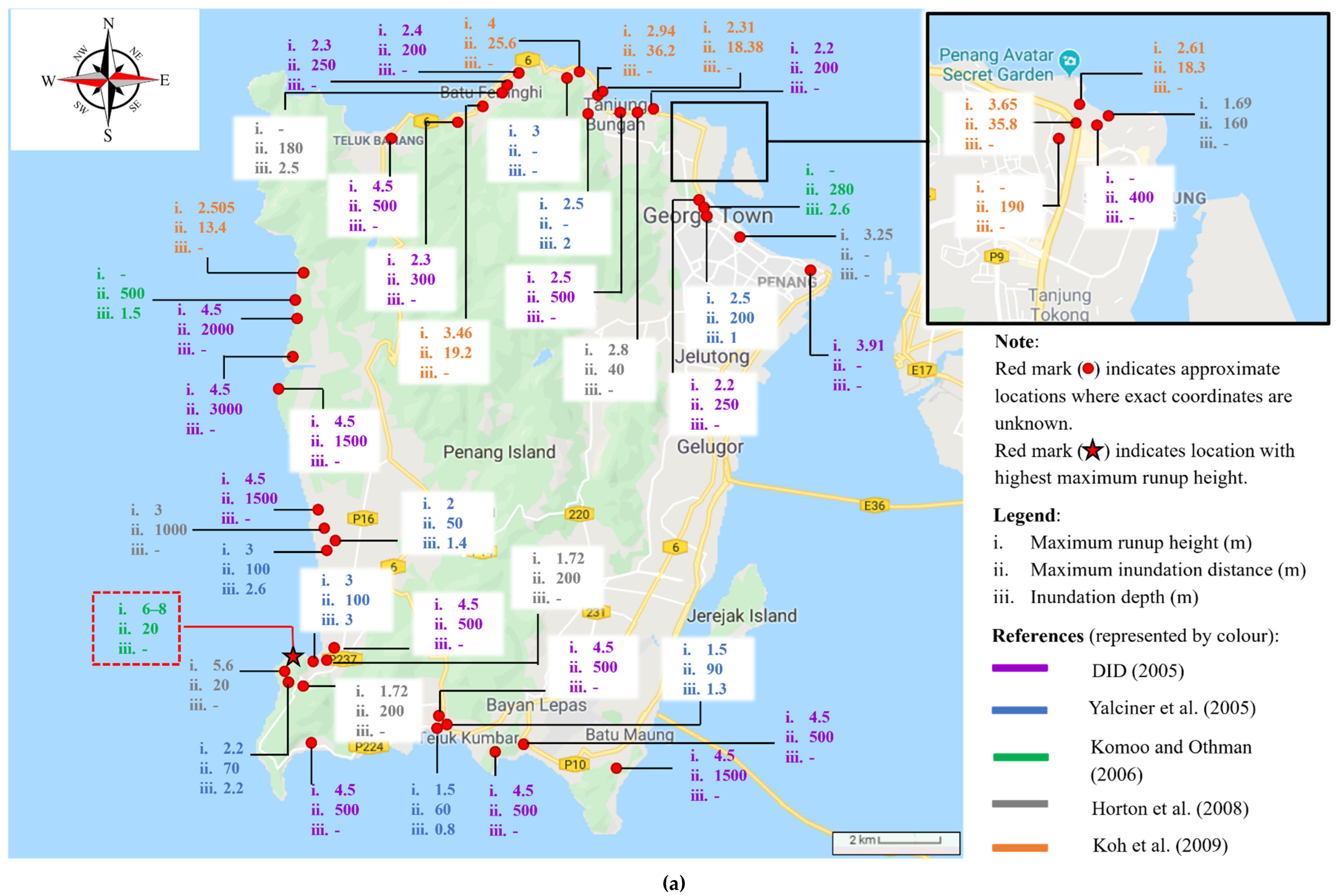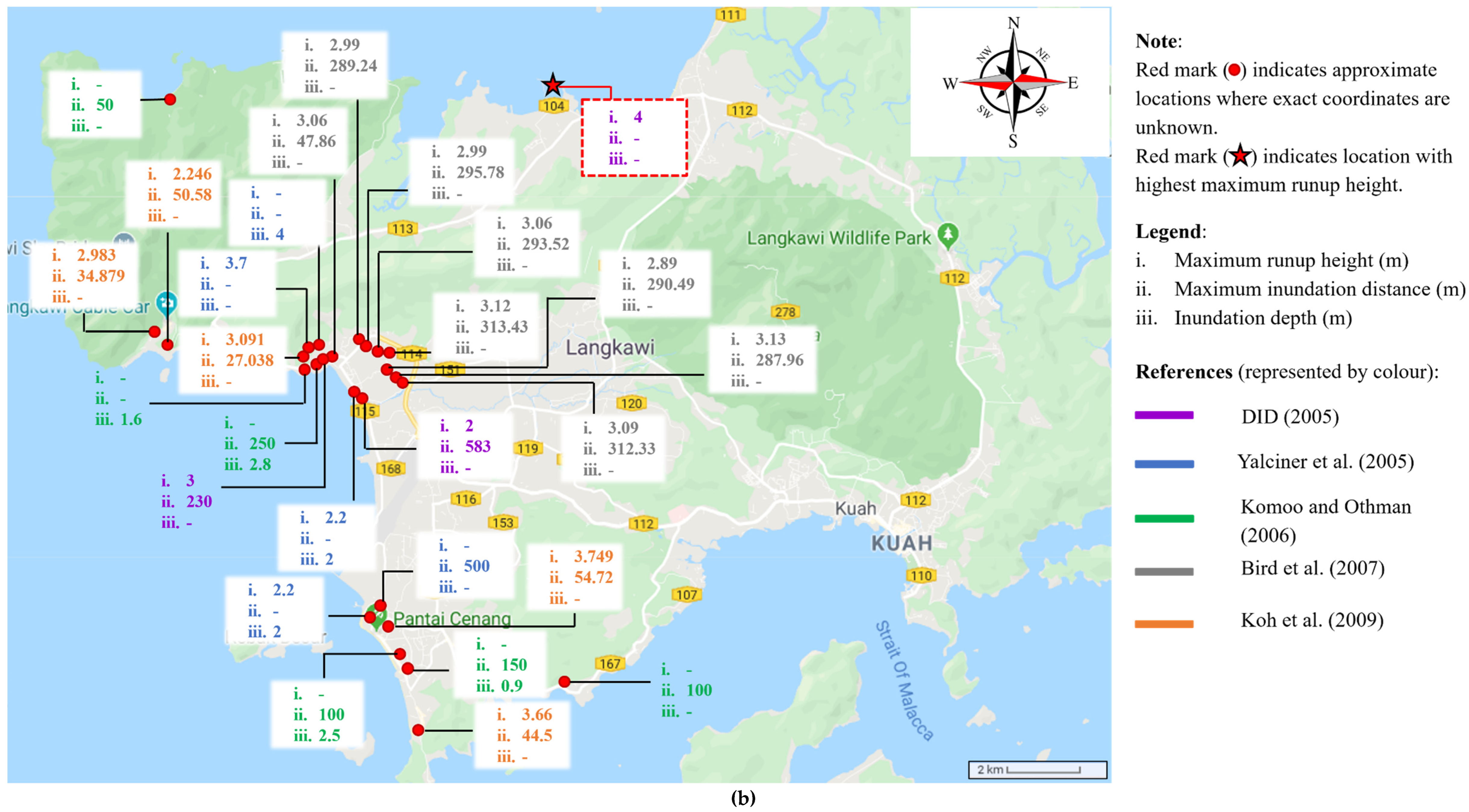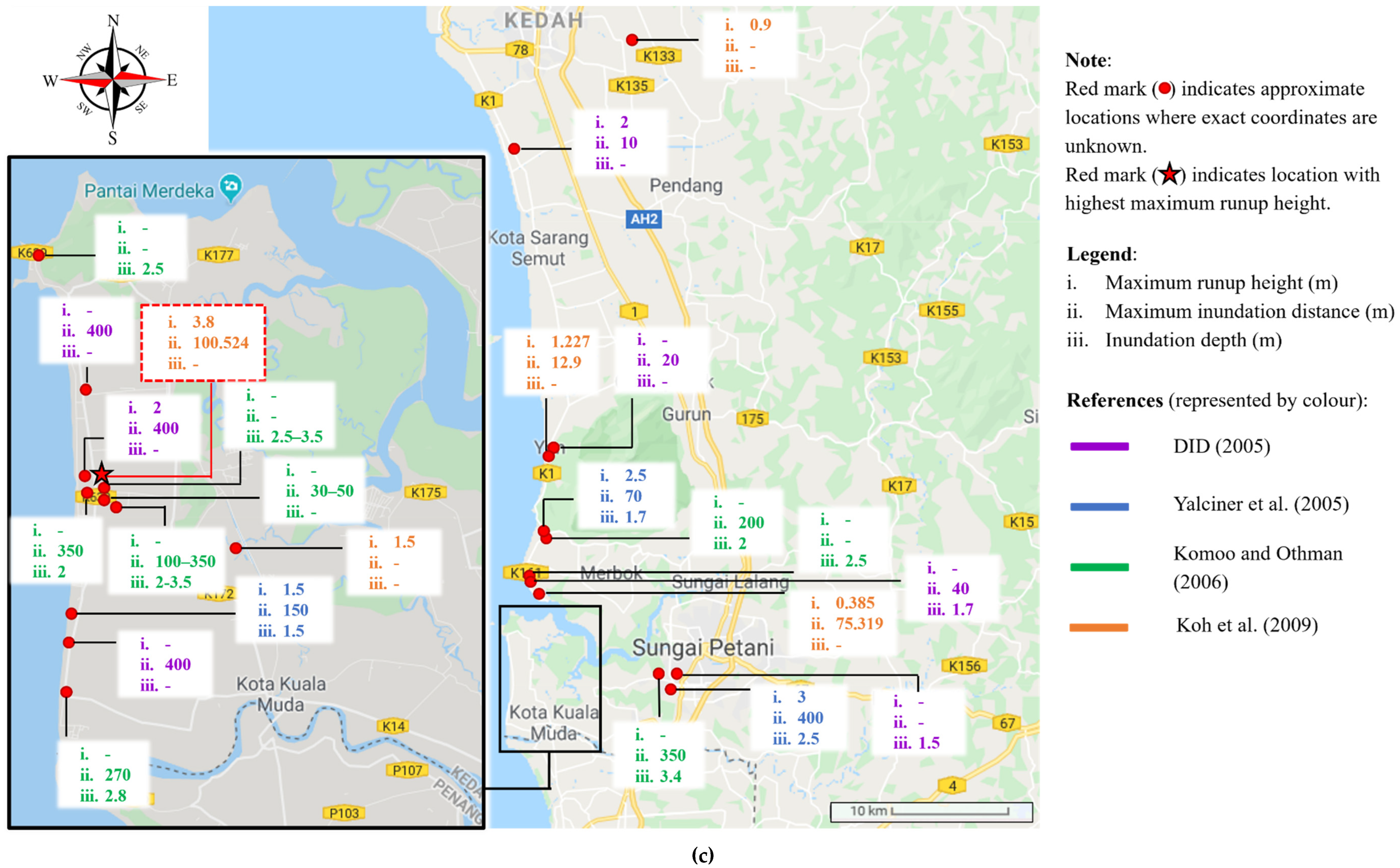A Shared Vision on the 2004 Indian Ocean Tsunami in Malaysia: Hazard Assessments, Post-Disaster Measures and Research
Abstract
1. Introduction
2. 2004 Indian Ocean Tsunami: Field Observations in Peninsular Malaysia
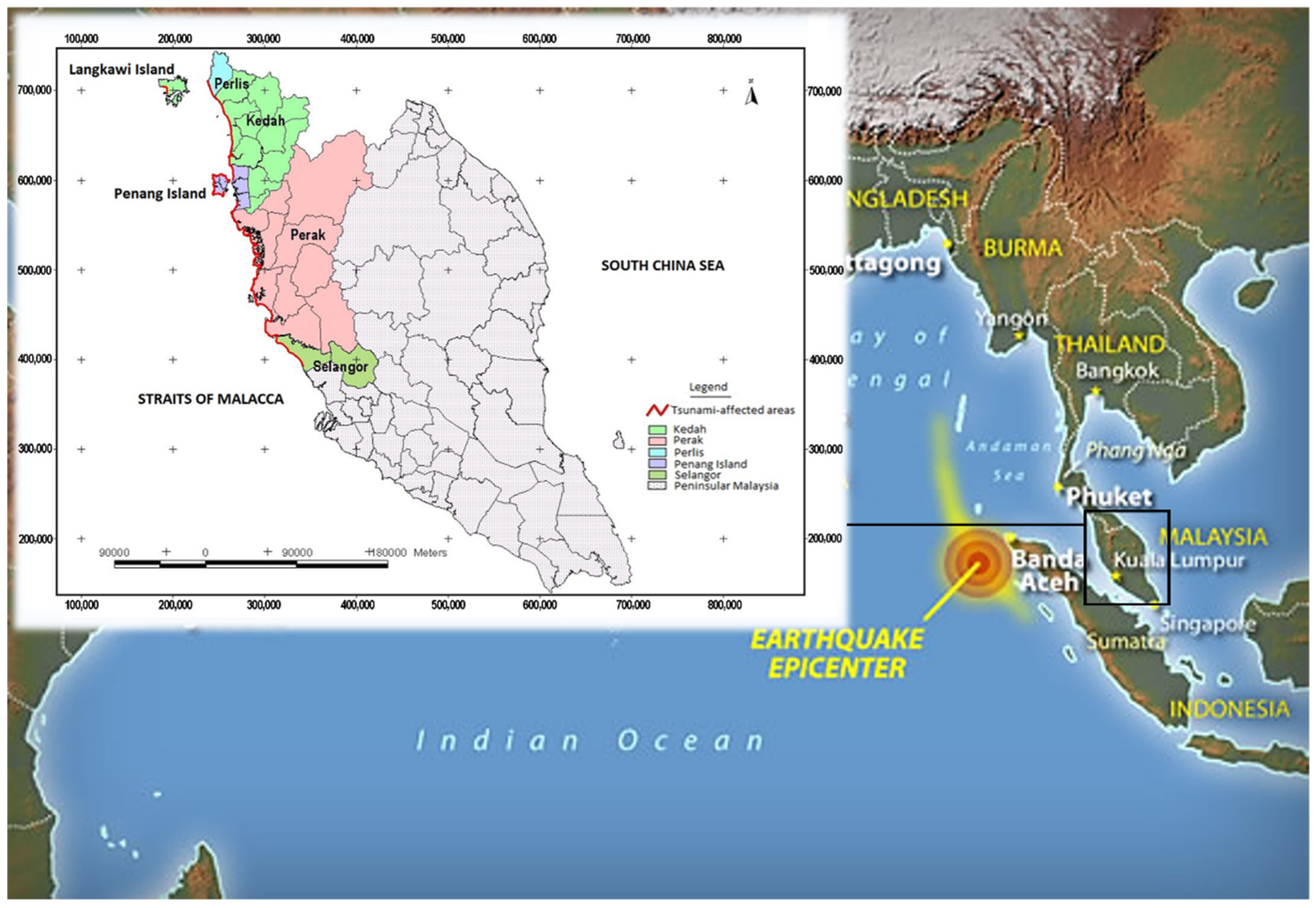
2.1. Tsunami Characteristics
| References | Incident Place | Flow Velocity (m/s) |
|---|---|---|
| Bird et al. [20] | Sungai Kuala Triang, Langkawi Island (6.328258, 99.847767) | 6.94 |
| Komoo and Othman [24] | Kota Kuala Muda | 8.33 |
2.2. Building Damage
3. Assessment of Tsunami Threats to the Coast of Malaysia
3.1. Tsunami Hazard Zoning
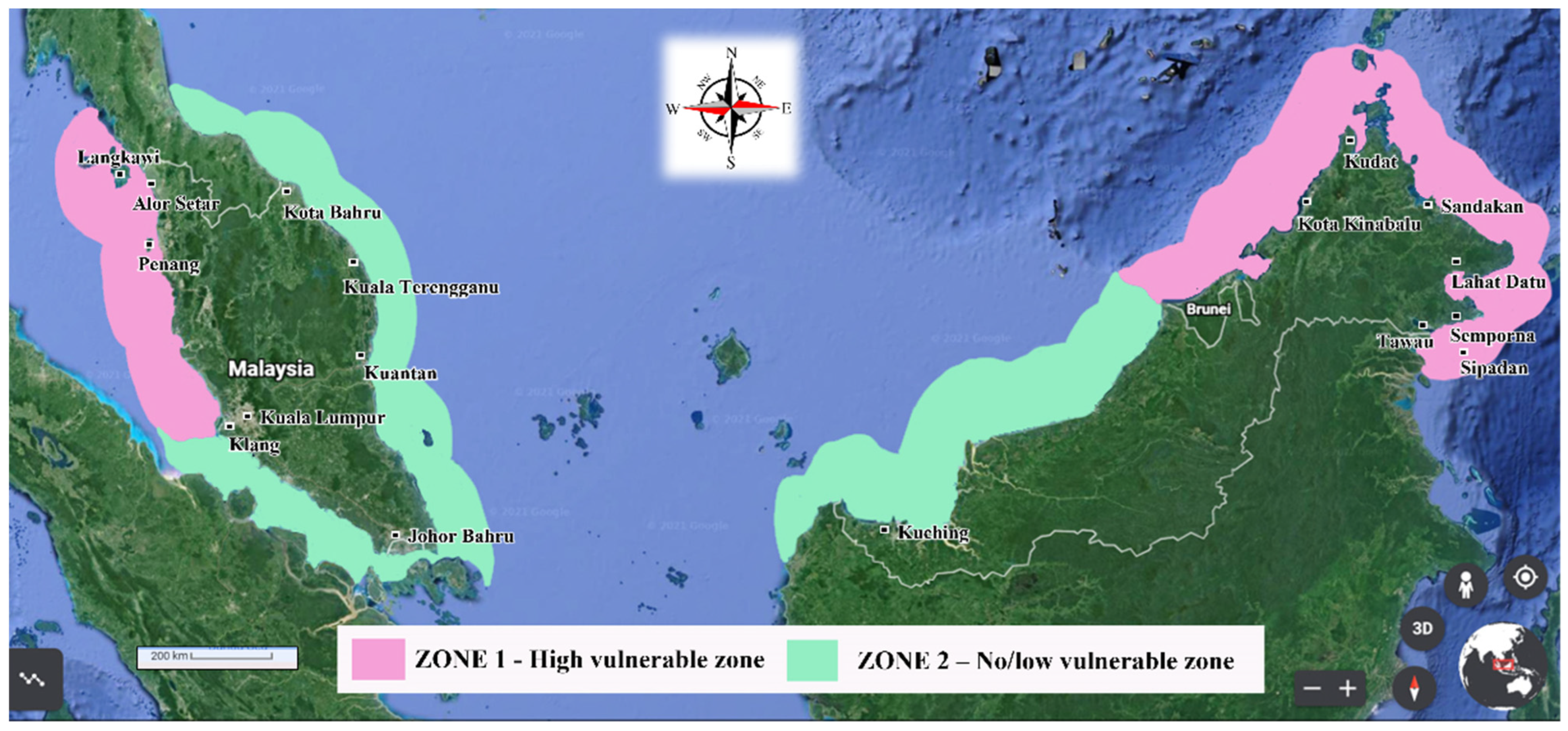
3.2. Worst-Case Scenario Simulation
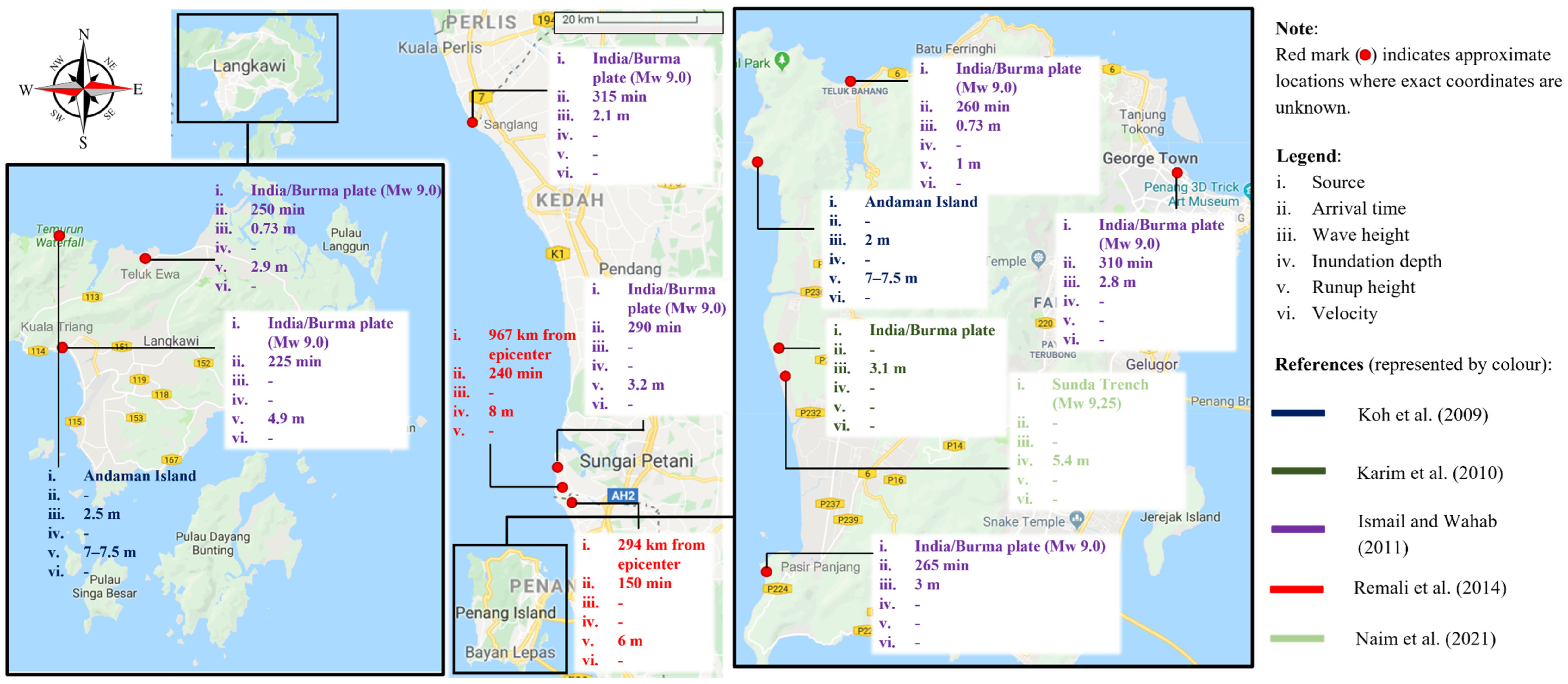
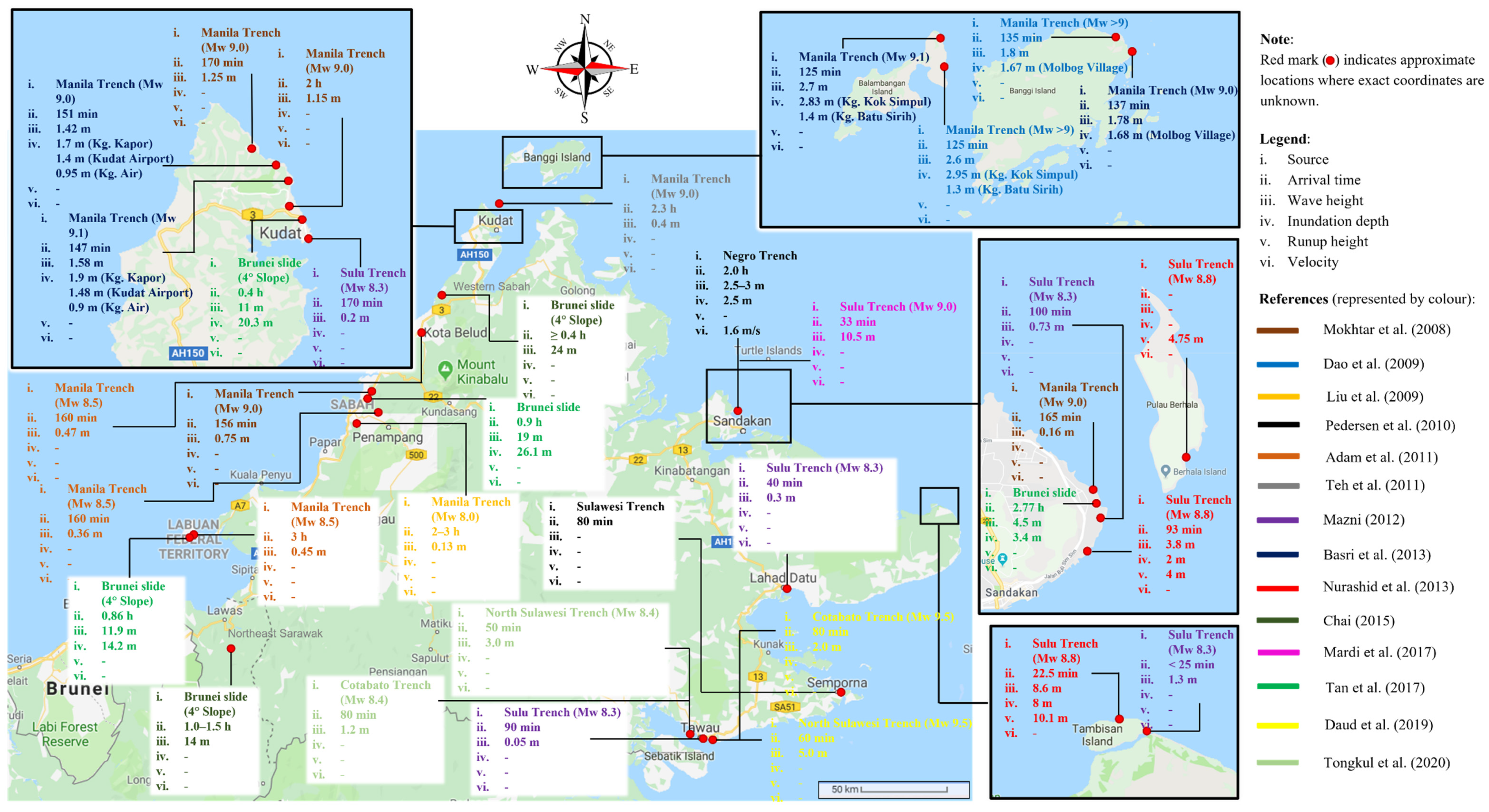
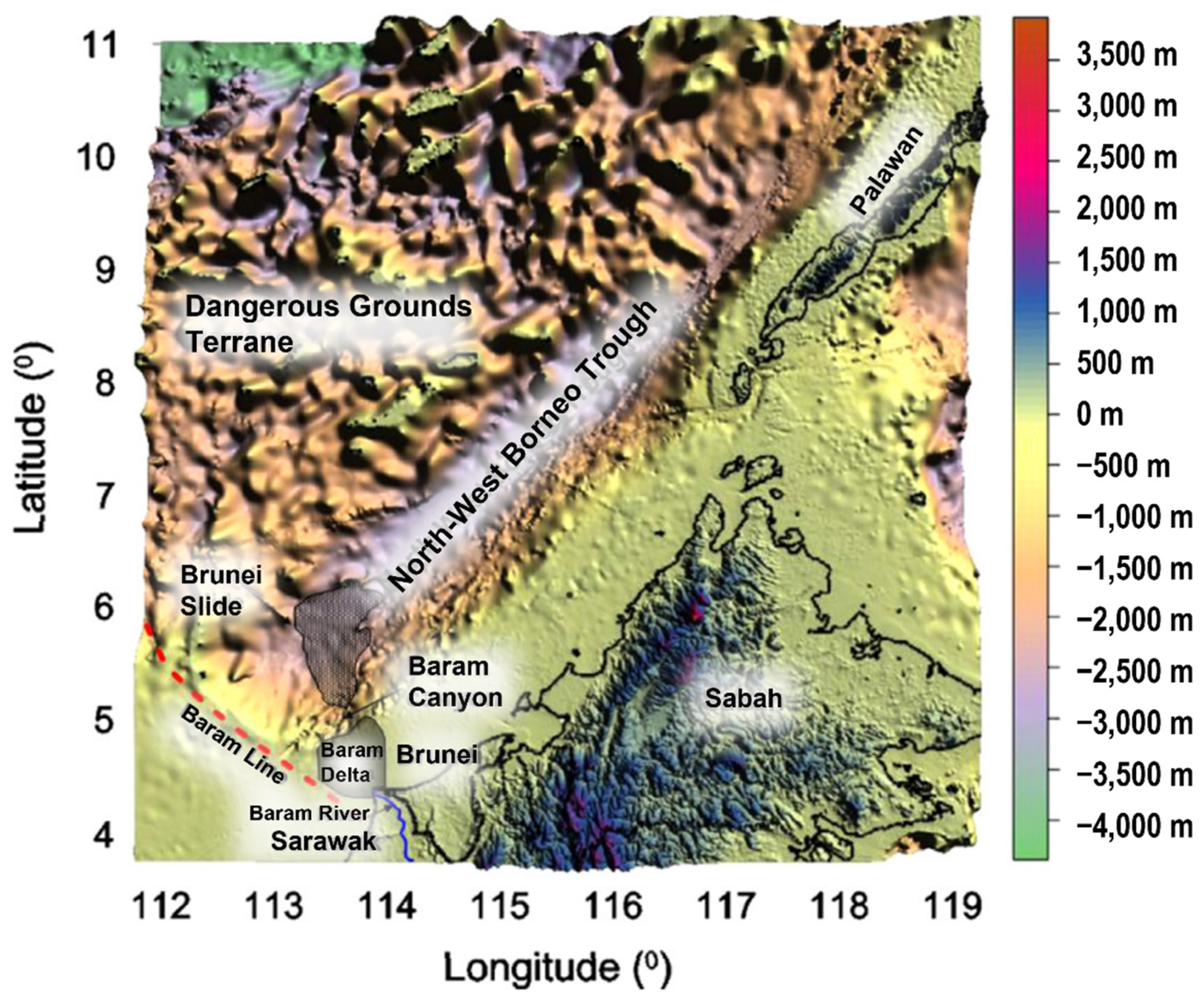
4. Post-2004 Measures and Research in Malaysia
4.1. Disaster Risk Management
4.2. Studies on Coastal Protections
4.3. Studies on Tsunami Force Estimation
5. Challenges and Future Perspectives
6. Conclusions
Author Contributions
Funding
Institutional Review Board Statement
Informed Consent Statement
Data Availability Statement
Acknowledgments
Conflicts of Interest
Appendix A
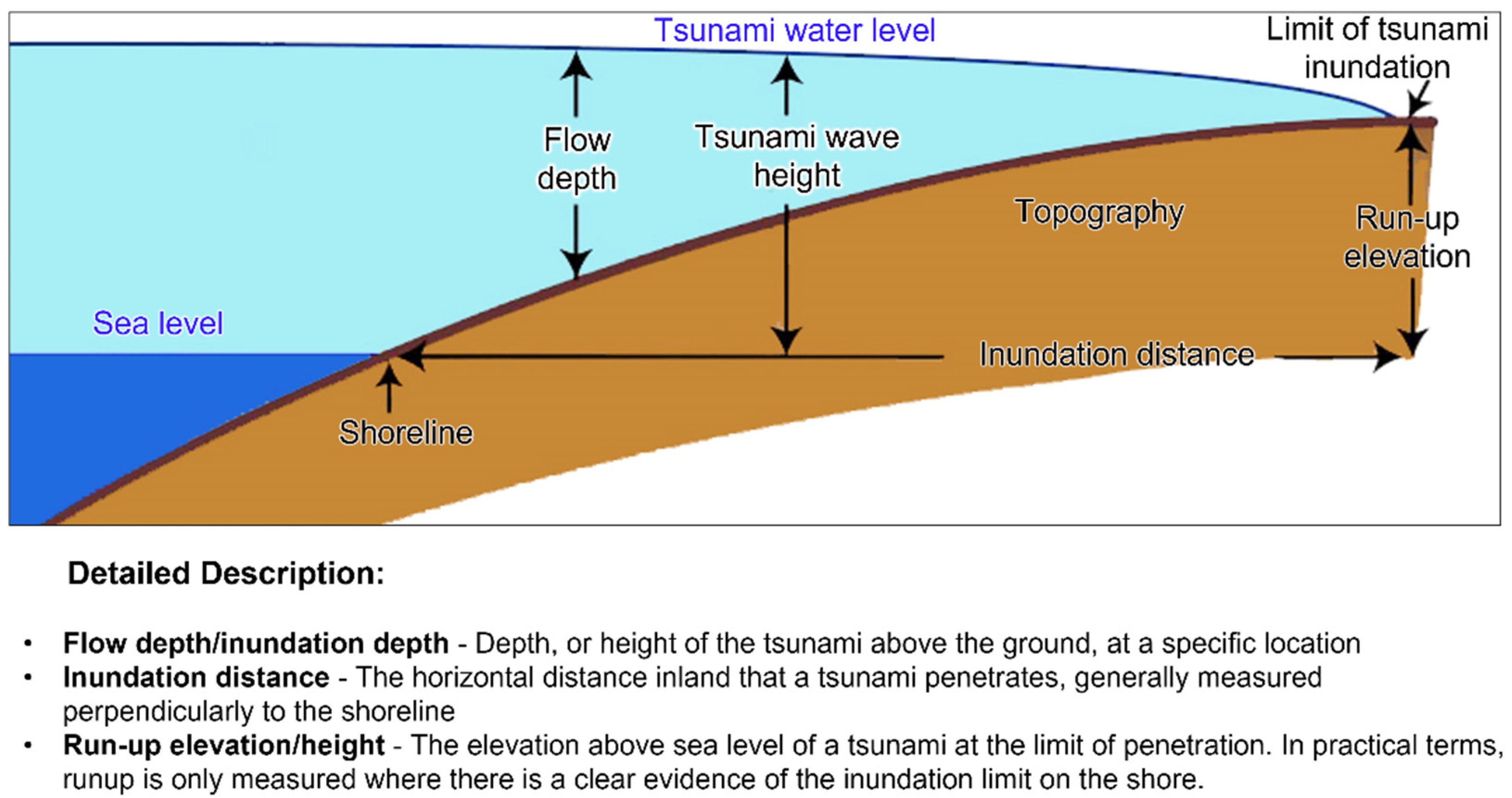
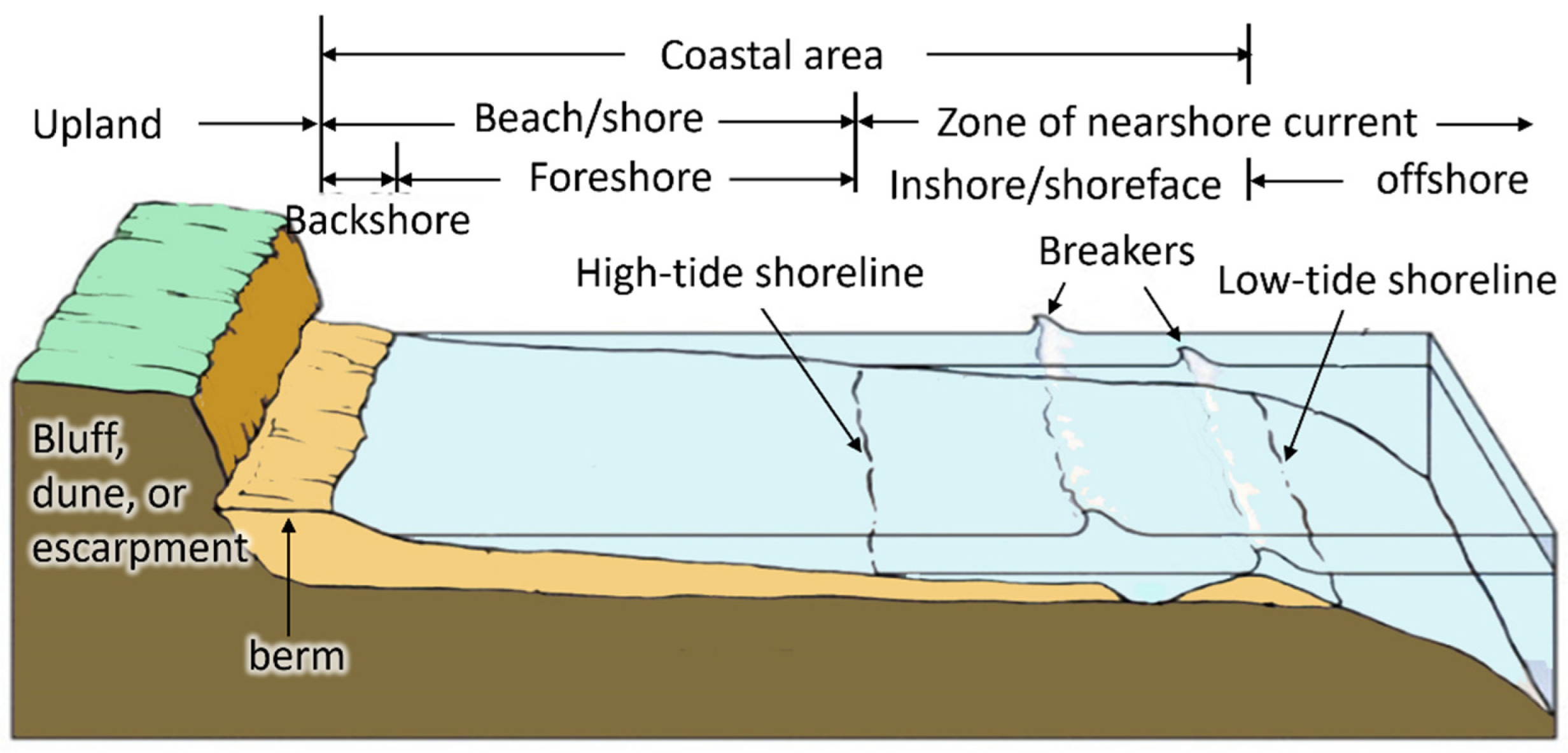
References
- Gusiakov, V.K.; Dunbar, P.K.; Arcos, N. Twenty-five years (1992–2016) of global tsunamis: Statistical and analytical overview. Pure Appl. Geophys. 2019, 176, 2795–2807. [Google Scholar] [CrossRef]
- Qiu, L.-C.; Tian, L.; Liu, X.-J.; Han, Y. A 3D multiple-relaxation-time LBM for modeling landslide-induced tsunami waves. Eng. Anal. Bound. Elem. 2019, 102, 51–59. [Google Scholar] [CrossRef]
- Guha-Sapir, D.; Below, R.; Hoyois, P. EM-DAT: International Disaster Database; Catholic University of Louvain: Brussels, Belgium, 2015; pp. 57–58. [Google Scholar]
- Koshimura, S. Tsunami. In Encyclopedia of Ocean Sciences, 3rd ed.; Cochran, J.K., Bokuniewicz, H.J., Yager, P.L., Eds.; Academic Press: Oxford, UK, 2019; pp. 692–701. [Google Scholar]
- Gupta, H.K.; Gahalaut, V.K. Three Great Tsunamis: Lisbon (1755), Sumatra-Andaman (2004) and Japan (2011); Springer: London, UK, 2013. [Google Scholar]
- Baptista, M.A.; Miranda, J.M. Revision of the Portuguese catalog of tsunamis. Nat. Hazards Earth Syst. Sci. 2009, 9, 25–42. [Google Scholar] [CrossRef]
- Lander, J.F.; Whiteside, L.; Lockridge, P.A. A brief history of tsunamis in the Caribbean Sea. Sci. Tsunami Hazards 2002, 20, 222–238. [Google Scholar]
- Anita, G.; Sandri, L.; Marzocchi, W.; Argnani, A.; Gasparini, P.; Selva, J. Probabilistic tsunami hazard assessment for messina strait area (Sicily, Italy). Nat. Hazards 2012, 64, 329–358. [Google Scholar] [CrossRef]
- Berninghausen, W.H. Tsunamis reported from the west coast of South America 1562–1960. Bull. Seismol. Soc. Am. 1962, 52, 915–921. [Google Scholar]
- Krüger, F.; Ohrnberger, M. Tracking the rupture of the Mw = 9.3 Sumatra earthquake over 1150 km at teleseismic distance. Nature 2005, 435, 937–939. [Google Scholar] [CrossRef] [PubMed]
- Colbourne, F.W. Tsunami impact on the west coast of Penang Island, Malaysia. Research Project Report; Emporia State University: Emporia, KS, USA, 2005. [Google Scholar]
- ADB. An Initial Assessment of the Impact of the Earthquake and Tsunami of December 26, 2004 on South and Southeast Asia; 0308-597X; Asian Developement Bank: Manila, Philippines, 2005. [Google Scholar]
- Lau, T.L.; Majid, T.A.; Choong, K.K.; Zaini, S.S. Public awareness on earthquake and tsunami survey in Penang. Jurutera Bull. Inst. Eng. Malays. 2005, 14–18. [Google Scholar]
- Ismail, H.; Wahab, A.A.; Amin, M.M.; Yunus, M.M.; Sidek, F.J. A 3-tier tsunami vulnerability assessment technique for the north-west coast of Peninsular Malaysia. Nat. Hazards 2012, 63, 549–573. [Google Scholar] [CrossRef]
- Shaluf, I.M.; Ahmadun, F.l.-R. Disaster types in Malaysia: An overview. Disaster Prev. Manag. Int. J. 2006, 15, 286–298. [Google Scholar] [CrossRef]
- Martin, J.D. Malaysia: Disaster Management Reference Handbook; Center for Excellence in Disaster Management & Humanitarian Assistance: Kuala Lumpur, Malaysia, 2019; pp. 1–95. [Google Scholar]
- Abdullah, K.; Tan, K.; Ghazali, N. No more in the comfort zone–Malaysia’s response to the December 2004 Tsunami. In Proceedings of the International Hydrography and Oceanography Conference and Exhibition, Kuala Lumpur, Malaysia, 5–7 July 2005; pp. 1–28. [Google Scholar]
- Ahmadun, F.l.-R.; Wong, M.M.R.; Said, A.M. Consequences of the 2004 Indian ocean tsunami in Malaysia. Saf. Sci. 2020, 121, 619–631. [Google Scholar] [CrossRef]
- Yalciner, A.; Ghazali, N.; Abd Wahab, A. Report on December 26, 2004, Indian Ocean Tsunami, Field Survey on July 09–10, 2005 North West of Malaysia, Penang and Langkawi Islands; Australian Institute of Marine Science: Townsville, Australia, 2005. [Google Scholar]
- Bird, M.; Cowie, S.; Hawkes, A.; Horton, B.; Macgregor, C.; Ong, J.E.; Aileen, T.S.H.; Teh, T.S.; Yasin, Z. Indian Ocean tsunamis: Environmental and socio-economic impacts in Langkawi, Malaysia. Geogr. J. 2007, 173, 103–117. [Google Scholar] [CrossRef]
- Horton, B.; Bird, M.; Birkland, T.; Cowie, S.; Eong, O.J.; Hawkes, A.; Khoon, G.W.; Law, L.; Macgregor, C.; Shau-Hwai, A.T.; et al. Environmental and socioeconomic dynamics of the Indian Ocean tsunami in Penang, Malaysia. Singap. J. Trop. Geogr. 2008, 29, 307–324. [Google Scholar] [CrossRef]
- DID. Laporan Penyiasatan Pasca-Tsunami 26 Disember 2004; Department of Irrigation and Drainage: Kuala Lumpur, Malaysia, 2005.
- Koh, H.L.; Teh, S.Y.; Liu, P.L.F.; Ismail, A.I.M.; Lee, H.L. Simulation of Andaman 2004 tsunami for assessing impact on Malaysia. J. Asian Earth Sci. 2009, 36, 74–83. [Google Scholar] [CrossRef]
- Komoo, I.; Othman, M. The 26.12.04 Tsunami Disaster in Malaysia: An Environmental, Socio-Economic and Community Well-Being Impact Study; Akademi Sains Malaysia: Kuala Lumpur, Malaysia, 2006. [Google Scholar]
- ITIC. Tsunami Glossary. Available online: http://itic.ioc-unesco.org/index.php?option=com_content&view=category&id=1142&Itemid=2433 (accessed on 30 July 2022).
- FEMA P-55. Coastal Construction Manual: Principles and Practices of Planning, Siting, Designing, Constructing, and Maintaining Residential Buildings in Coastal Areas, 4th ed.; Federal Emergency Management Agency: Washington, DC, USA, 2011.
- DID. Volume 3—Coastal Management; 2041-9139; Department of Irrigation and Drainage: Kuala Lumpur, Malaysia, 2009. [Google Scholar]
- Lee, Y.L.; Affendi, Y.A.; Tajuddin, B.H.; Yusuf, Y.B.; Kee Alfan, A.A.; Anuar, E.A. A post-tsunami assessment of coastal living resources of Langkawi Archipelago, Peninsular Malaysia. NAGA WorldFish Cent. Newsl. 2005, 28, 17–22. [Google Scholar]
- Asmawi, M.Z.; Ibrahim, A.N. The impacts of tsunami on the well-being of the affected community in Kuala Muda, Kedah, Malaysia. J. Clean Energy Technol. 2013, 1, 246–250. [Google Scholar] [CrossRef]
- Nordin, J.; Charleson, A.W. Tsunami responsive architecture: Reducing vulnerability of houses and other structures along the northwestern coast of Malaysia. In Proceedings of the 4th Annual International Workshop & Expo on Sumatra Tsunami Disaster & Recovery, 23–24 November 2009; pp. 20–24. [Google Scholar]
- Van de Lindt, J.W.; Gupta, R.; Cox, D.T.; Wilson, J.S. Wave impact study on a residential building. J. Disaster Res. 2009, 4, 419–426. [Google Scholar] [CrossRef]
- Chock, G. ASCE 7 and the Development of a Tsunami Building Code for the U.S.; American Society of Civil Engineers: Honolulu, HI, USA, 2013. [Google Scholar]
- Foong, S.L.; Shiozaki, Y.; Horita, Y. Evaluation of the reconstruction plans for tsunami victims in Malaysia. J. Asian Archit. Build. Eng. 2006, 5, 293–300. [Google Scholar]
- Roosli, R.; Baharum, F. Human rights violation in providing adequate post-disaster housing in Malaysia: An updated review. Aust. J. Basic Appl. Sci. 2012, 6, 440–447. [Google Scholar]
- Rostam, K.; Herman, I.; Mohd Nor, A.B. Resettlement areas of tsunami victims in Malaysia: An analysis of neighbourhood quality and well-being. Geogr.-Malays. J. Soc. Space 2017, 5, 33–43. [Google Scholar]
- MOSTI. Seismic and Tsunami Hazards and Risks Study in Malaysia; Academy of Sciences Malaysia: Kuala Lumpur, Malaysia, 2009; pp. 1–46. [Google Scholar]
- Remali, N.; Daud, M.E.; Kaamin, M.; Arus, H.M.; Sarif, A.S.; Ibrahim, M.F. Modeling Tsunami Propagation for Tsunami Disaster Reduction in Kota Kuala Muda, Kedah. Available online: https://www.academia.edu/2569270/Modeling_Tsunami_Propagation_for_Tsunami_Disaster_Reduction_in_Kota_Kuala_Muda_Kedah (accessed on 12 January 2018).
- Roy, G.D.; Karim, M.F.; Ismail, A.I.M. A nonlinear polar coordinate shallow water model for tsunami computation along North Sumatra and Penang Island. Cont. Shelf Res. 2007, 27, 245–257. [Google Scholar]
- Karim, M.F.; Ismail, A.I.M.; Meah, M.A. A one-way nested tsunami computation model for the Penang Island in Peninsular Malaysia. In Proceedings of the 7th WSEAS international conference on System science and simulation in engineering, Venice, Italy, 21–23 November 2008; pp. 47–54. [Google Scholar]
- Meah, M.A.; Alam, M.J.; Noor, M.S.; Sadhu, P.P. Open boundary condition for distant tsunami computation—A linear case. Sci. Tsunami Hazards 2011, 30, 24–42. [Google Scholar]
- Roy, G.; Ismail, A. An investigation on the propagation of 26 December 2004 tsunami waves towards the west coast of Malaysia and Thailand using a Cartesian coordinates shallow water model. In Proceedings of the International Conference in Mathematics and Applications, Mahidol University, Bangkok, Thailand, 15–17 December 2005; pp. 389–410. [Google Scholar]
- Shaari, N.A.; Fujii, Y.; Yanagisawa, H. Validation of tsunami inundation modeling for the 2004 Sumatra-Andaman earthquake for making hazard maps in Penang and Langkawi, Malaysia. Bull. Int. Inst. Seismol. Earthq. Eng. 2013, 47, 121–126. [Google Scholar]
- Ghazali, N.H.M.; Awang, N.A.; Mahmud, M.; Mokhtar, A. Impact of sea level rise and tsunami on coastal areas of North-West Peninsular Malaysia. Irrig. Drain. 2018, 67, 119–129. [Google Scholar] [CrossRef]
- Ismail, H.; Wahab, A.K.A. Numerical experiments on tsunami propagation into the Straits of Malacca. In Tsunami Simulation for Impact Assessment; Koh, H., Philip, L.-F.L., Teh, S.Y., Eds.; Universiti Sains Malaysia Press: Pulau Pinang, Malaysia, 2011; pp. 174–185. [Google Scholar]
- Karim, F.; Ismail, M.; Izani, A. Estimation of expected maximum water level due to tide and tsunami interaction along the coastal belts of Penang Island in Peninsular Malaysia. Sci. Tsunami Hazards 2010, 29, 127–138. [Google Scholar]
- Naim, N.N.N.; Mardi, N.H.; Malek, M.A.; Teh, S.Y.; Wil, M.A.; Ahmed, A.N. Tsunami inundation maps for the northwest of Peninsular Malaysia and demarcation of affected electrical assets. Environ. Monit. Assess. 2021, 193, 1–17. [Google Scholar] [CrossRef]
- Nelvindran, G.; Mardi, N.H.; Malek, M.A.; Tan, W.K.; Teh, S.Y. Simulation of tsunami at east coast of Peninsular Malaysia due to the earthquakes at Manila Trench using Tuna-M2 model. Int. J. Civ. Eng. Technol. 2019, 10, 41–50. [Google Scholar]
- Raj, J.K. Tsunami threat to coastal areas of Sabah, East Malaysia. Geol. Soc. Malays. Bull. 2007, 53, 51–57. [Google Scholar]
- Basri, S.N.; Fujii, Y.; Shibazaki, B.; Yanagisawa, H. Study on tsunami inundation simulation in the northwestern coast of Sabah, Malaysia. Bull. Int. Inst. Seismol. Earthq. Eng. 2013, 47, 133–138. [Google Scholar]
- Dao, M.H.; Tkalich, P.; Chan, E.S.; Megawati, K. Tsunami propagation scenarios in the South China Sea. J. Asian Earth Sci. 2009, 36, 67–73. [Google Scholar] [CrossRef]
- Liu, P.L.F.; Wang, X.; Salisbury, A.J. Tsunami hazard and early warning system in South China Sea. J. Asian Earth Sci. 2009, 36, 2–12. [Google Scholar] [CrossRef]
- Mokhtar, Z.A.B.; Imamura, F.; Koshimura, S. Study on appropriate modeling of tsunamis in Malaysia for risk evaluation. Bull. Int. Inst. Seismol. Earthq. Eng. 2008, 42, 139–144. [Google Scholar]
- Teh, S.Y.; Koh, H.L.; Moh, Y.T.; DeAngelis, D.L.; Jiang, J. Tsunami risk mapping simulation for Malaysia. WIT Trans. Built Environ. 2011, 119, 3–14. [Google Scholar]
- Adam, M.R.B. Numerical simulation as guidance in making tsunami hazard map for Labuan Island. Bull. Int. Inst. Seismol. Earthq. Eng. 2011, 45, 121–126. [Google Scholar]
- Mazni, A. Tsunami numerical simulation around Sulu Sea and Celebes Sea. Bull. Int. Inst. Seismol. Earthq. Eng. 2012, 46, 109–114. [Google Scholar]
- Nurashid, N.I.; Shibazaki, B.; Fujii, Y.; Yanagisawa, H. Tsunami inundation modeling along the east coast of Sabah, Malaysia for potential earthquakes in Sulu Sea. Bull. Int. Inst. Seismol. Earthq. Eng. 2013, 47, 127–132. [Google Scholar]
- Mardi, N.H.; Malek, M.A.; Liew, M.S. Tsunami simulation due to seaquake at Manila Trench and Sulu Trench. Nat. Hazards 2017, 85, 1723–1741. [Google Scholar] [CrossRef]
- Pedersen, C.; Latif, Z.A.; Lai, C. Tsunami modelling and risk mapping for east coast of Sabah, Malaysia. In Proceedings of the Coastal Engineering Proceedings, Shanghai, China, 30 November 2010; pp. 55–64. [Google Scholar]
- Daud, A.K.T.M.; Tongkul, F.; Roslee, R. The scenario of tsunami propagation at the Celebes Sea and the disaster impacts to Tawau district. ASM Sci. J. 2019, 12, 82–90. [Google Scholar]
- Tongkul, F.; Roslee, R.; Daud, A.K.T.M. Assessment of tsunami hazard in Sabah—Level of threat, constraints and future work. Bull. Geol. Soc. Malays. 2020, 20, 1–15. [Google Scholar] [CrossRef]
- Chai, M.F. Simulation of Brunei Slide Tsunamis for Coastal Inundation and Hazard. Doctoral Dissertation, Universiti Sains Malaysia, Gelugor, Malaysia, 2015. [Google Scholar]
- Tan, W.K.; Teh, S.Y.; Koh, H.L. Tsunami run-up and inundation along the coast of Sabah and Sarawak, Malaysia due to a potential Brunei submarine mass failure. Environ. Sci. Pollut. Res. 2017, 24, 15976–15994. [Google Scholar] [CrossRef]
- Watts, P.; Grilli, S.T.; Kirby, J.T.; Fryer, G.J.; Tappin, D.R. Landslide tsunami case studies using a Boussinesq model and a fully nonlinear tsunami generation model. Nat. Hazards Earth Syst. Sci. 2003, 3, 391–402. [Google Scholar] [CrossRef]
- Ren, Z.; Zhao, X.; Liu, H. Numerical study of the landslide tsunami in the South China Sea using Herschel-Bulkley rheological theory. Phys. Fluids 2019, 31, 056601. [Google Scholar]
- Koh, H.L.; Teh, S.Y.; Tan, W.K.; Chan, L.G.; Ho, C.K. Langkawi tsunami hazards mitigation and inundation maps. J. Eng. Appl. Sci. 2017, 12, 4801–4808. [Google Scholar]
- Koh, H.L.; Liu, P.L.; Teh, S.Y. Tsunami Simulation for Impact Assessment; Penerbit Universiti Sains Malaysia: Penang, Malaysia, 2011; p. 249. [Google Scholar]
- Koh, H.L.; Liu, P.L.; Teh, S.Y. Tsunami Education, Protection and Preparedness; Penerbit Universiti Sains Malaysia: Penang, Malaysia, 2011. [Google Scholar]
- MMD. Seismic and tsunami observations of Malaysia; Malaysian Meteorological Department: Kuala Lumpur, Malaysia, 2011.
- Said, A.M.; Ahmadun, F.L.-R.; Mahmud, A.R.; Abas, F. Community preparedness for tsunami disaster: A case study. Disaster Prev. Manag. 2011, 20, 266–280. [Google Scholar] [CrossRef]
- UNESCO. Tsunami Center for South China Sea Becomes Fully Operational on World Tsunami Awareness Day. Available online: https://en.unesco.org/news/tsunami-center-south-china-sea-becomes-fully-operational-world-tsunami-awareness-day (accessed on 14 March 2021).
- Ismail, M.K.Z.; Omar, B.Z.C.; Pereira, J.J.; Aziz, S.A.A.G. Sendai framework implementation in Malaysia: Opportunities and challenges. In Proceedings of the Asian Ministerial Conference on Disaster Risk Reduction (AMCDRR), Ulaanbaatar, Mongolia, 3–6 July 2018; pp. 1–14. [Google Scholar]
- UNDRR. Disaster Risk Reduction in Malaysia: Status Report 2020; 2212-4209; United Nations Office for Disaster Risk Reduction—Regional Office for Asia and Pacific Asian Disaster Preparedness Center: Kuala Lumpur, Malaysia, 2020; pp. 1–37.
- Zahari, R.K.; Ariffin, R.N.R.; Asmawi, Z.; Ibrahim, A.N. Post-2004 tsunami: Preparedness of Malaysian coastal communities. J. ASIAN Behav. Stud. 2018, 3, 113–121. [Google Scholar] [CrossRef]
- Mustakim, N.S.; Lateh, H.; Razali, M.Z. The effectiveness of tsunami disaster awareness programme: A case study in Kota Kuala Muda, Kedah. Geogr.-Malays. J. Soc. Space 2020, 16, 66–79. [Google Scholar]
- Teo, F.; Falconer, R.A.; Lin, B. Modelling effects of mangroves on tsunamis. Proceedings of the Institution of Civil Engineers-Water Management 2009, 162, 3–12. [Google Scholar] [CrossRef]
- Shuto, N.; Fujima, K. A short history of tsunami research and countermeasures in Japan. Proc. Jpn. Acad. Ser. B 2009, 85, 267–275. [Google Scholar] [CrossRef]
- Omira, R.; Baptista, M.A.; Leone, F.; Matias, L.; Mellas, S.; Zourarah, B.; Miranda, J.M.; Carrilho, F.; Cherel, J.-P. Performance of coastal sea-defense infrastructure at El Jadida (Morocco) against tsunami threat: Lessons learned from the Japanese 11 March 2011 tsunami. Nat. Hazards Earth Syst. Sci. 2013, 13, 1779–1794. [Google Scholar] [CrossRef]
- Shuto, N. Tsunamis—Their Coastal Effects and Defense Works. International Compendium of Coastal Engineering; World Scientific: Singapore, 2015; pp. 55–84. [Google Scholar]
- Muhammad, R.A.H.; Tanaka, N. Energy reduction of a tsunami current through a hybrid defense system comprising a sea embankment followed by a coastal forest. Geosciences 2019, 9, 247. [Google Scholar] [CrossRef]
- Jahromi, B.E.; Sidek, F.J. Conceptualization of submerrged structures as tsunami barrier. Malays. J. Civil. Eng. 2010, 22, 83–94. [Google Scholar]
- Rahman, S.; Akib, S.; Khan, M.; Shirazi, S. Experimental study on tsunami risk reduction on coastal building fronted by sea wall. Sci. World J. 2014, 32, 729357. [Google Scholar] [CrossRef] [PubMed]
- Maqtan, R.; Yusuf, B.; Hamzah, S.B. Physical modeling of landward scour due to tsunami bore overtopping seawall. MATEC Web Conf. 2018, 203, 01003. [Google Scholar] [CrossRef][Green Version]
- Ibrahim, I.N.i.; Ab Razak, M.S.; Yusof, B.; Desa, S.M. The performance of narrow and broad-crested submerged breakwaters in dissipating wave heights. J. Teknol. 2020, 82, 25–33. [Google Scholar] [CrossRef]
- Pereira, E.J.; Teh, H.M.; Chan, W.L.; Silavaraj, T. Performance Efficiency of a Membrane-Type Floating Breakwater for Protection of Coastal and Offshore Facilities. In Proceedings of the IOP Conference Series: Earth and Environmental Science, Changchun, China, 21–23 December 2020; p. 012058. [Google Scholar]
- Koh, H.L.; Teh, S.Y.; Kh’ng, X.Y.; Raja Barizan, R.S. Mangrove forests: Protection against and resilience to coastal disturbances. J. Trop. For. Sci. 2018, 30, 446–460. [Google Scholar] [CrossRef]
- Teh, S.Y.; Koh, H.L.; Liu, P.L.F.; Ismail, A.I.M.; Lee, H.L. Analytical and numerical simulation of tsunami mitigation by mangroves in Penang, Malaysia. J. Asian Earth Sci. 2009, 36, 38–46. [Google Scholar] [CrossRef]
- Teh, S.Y.; Koh, H.L.; Lim, Y.H. High Resolution Digital Elevation and Bathymetry Model for Tsunami Run-up and Inundation Simulation in Penang. J. Earthq. Tsunami 2019, 13, 1941001. [Google Scholar] [CrossRef]
- Hashim, A.M.; Catherine, S.M.P. A laboratory study on wave reduction by mangrove forests. APCBEE Procedia 2013, 5, 27–32. [Google Scholar] [CrossRef]
- Fateh, A.; Hejazi, F.; Tarmizi, M.A.; Shoaei, M.D.; Ghadiri, S.M. Performance of reinforced concrete and timber structure at kuala Muda Kedah during the tsunami. Int. J. Civil. Environ. Res. 2014, 1, 122–132. [Google Scholar]
- ADB. State of the Coral Triangle: Malaysia; 0308-597X; Asian Developement Bank: Manila, Philippines, 2014. [Google Scholar]
- Fauzi, N.F.M.; Min, T.H.; Hashim, A.M. Assessment of Mangrove Replanting Site at Kg Tanjung Kepah, Lekir, Perak. In Proceedings of the IOP Conference Series: Earth and Environmental Science, Changchun, China, 2020, 21–23 December; p. 012054.
- Scopus. Scopus Database. Available online: https://www.scopus.com/ (accessed on 28 June 2021).
- Moon, W.C.; Tan, K.C.; Lau, T.L. An experimental study on wave forces of tsunami on simplified onshore buildings at Penang Island, Malaysia. J. Civil. Eng. Res. 2014, 4, 164–172. [Google Scholar]
- Mazinani, I.; Ismail, Z.; Hashim, A.M.; Saba, A. Experimental investigation on tsunami acting on bridges. Int. J. Civ. Archit. Struct. Constr. Eng. 2014, 8, 1040–1043. [Google Scholar]
- Rahman, S.; Akib, S.; Shirazi, S. Experimental investigation on the stability of bride girder against tsunami forces. Sci. China Technol. Sci. 2014, 57, 2028–2036. [Google Scholar] [CrossRef]
- Lau, T.L.; Choong, K.K.; Majid, T.A.; Zakaria, N.A.; Inoue, S. Estimation of Tsunami Force for Onshore Buildings in the Northwest Coast of Peninsular Malaysia. Appl. Mech. Mater. 2015, 802, 172–177. [Google Scholar] [CrossRef]
- Mazinani, I.; Ismail, Z.; Shamshirband, S.; Hashim, A.; Mansourvar, M.; Zalnezhad, E. Estimation of tsunami bore forces on a coastal bridge using an extreme learning machine. Entropy 2016, 18, 167. [Google Scholar] [CrossRef]
- Rahman, S.; Khan, M.T.R. Physical assessment of wave forces on bridge girder impacted by potential tsunami hazard. ISH J. Hydraul. Eng. 2020, 28, 72–78. [Google Scholar] [CrossRef]
- Farahmandpour, O.; Marsono, A.K.; Tap, M.; Abu Bakar, S.; Forouzani, P. Experimental investigation of tsunami waterborne debris impact on structures. Int. J. GEOMATE 2016, 10, 2030–2035. [Google Scholar] [CrossRef]
- Chanson, H. Tsunami surges on dry coastal plains: Application of dam break wave equations. Coast Eng. J. 2006, 48, 355–370. [Google Scholar] [CrossRef]
- FEMA P-646. Guidelines for Design of Structures for Vertical Evacuation from Tsunamis; Federal Emergency Management Agency: Washington, DC, USA, 2012.
- Teh, H.M.; Philip, A.K.; Jaafar, A.; Shafiai, S.H.; Sahimy, M.R.M.; Rashidi, A.H.M. Impingement of Newtonian and non-Newtonian dry-bed bores on a vertical structure. In Proceedings of the OCEANS 2017, Aberdeen, UK, 19–22 June 2017; pp. 1–10. [Google Scholar]
- Faisal, N.A.A.; Ghani, A.N.A.; Salim, N.A.A. The Ability of Wall Openings to Reduce Flood Induced Forces On Residential Building. GEOMATE J. 2018, 14, 63–69. [Google Scholar]
- Moon, W.C.; Lau, T.L.; Puay, H.T. Experimental investigations of tsunami loading on internal wall of a building with various openings and wall configurations. Coast Eng. 2020, 158, 103691. [Google Scholar] [CrossRef]
- Mokhtar, Z.A.; Mohammed, T.A.; Yusuf, B.; Lau, T.L. Experimental investigation of tsunami bore impact pressure on a perforated seawall. Appl. Ocean Res. 2019, 84, 291–301. [Google Scholar] [CrossRef]
- Moon, W.C.; Chiew, L.Q.; Cheong, K.W.; Tee, Y.C.; Chun, J.B.; Lau, T.L. An experimental study for estimating tsunami wave forces acting on building with seaward and landward macroroughness. Ocean Eng. 2019, 186, 106116. [Google Scholar] [CrossRef]
- Moon, W.C.; Law, C.L.; Liew, K.K.; Koon, F.S.; Lau, T.L.; Law, C.L.; Liew, K.K.; Koon, F.S.; Lau, T.L. Tsunami force estimation for beachfront traditional buildings with elevated floor slab in Malaysia. Coast Eng. J. 2019, 61, 559–573. [Google Scholar] [CrossRef]
- Farahmandpour, O.; Marsono, A.K.; Forouzani, P.; Tap, M.; Abu Bakar, S. Experimental simulation of tsunami surge and its interaction with coastal structure. Int. J. Prot. Struct. 2020, 11, 258–280. [Google Scholar] [CrossRef]
- Nordin, J.; Charleson, A.; Gjerde, M. Tsunami modelling procedures to refine coastal architectural design strategies at Kuala Muda. Plan. Malays. J. 2018, 16, 81–91. [Google Scholar] [CrossRef]
- Thomas, S.; Killian, J.; Bridges, K. Influence of macroroughness on tsunami loading of coastal structures. J. Waterw. Port Coast Ocean Eng. 2015, 141, 04014028. [Google Scholar] [CrossRef]
- Yang, W.; Wen, Z.; Li, F.; Li, Q. Study on tsunami force mitigation of the rear house protected by the front house. Ocean Eng. 2018, 159, 268–279. [Google Scholar] [CrossRef]
- Robertson, I.N.; Riggs, H.R.; Yim, S.C.; Young, Y.L. Lessons from Hurricane Katrina storm surge on bridges and buildings. J. Waterw. Port Coast Ocean Eng. 2007, 133, 463–483. [Google Scholar] [CrossRef]
- Tomiczek, T.; Kennedy, A.; Rogers, S. Collapse limit state fragilities of wood-framed residences from storm surge and waves during Hurricane Ike. J. Waterw. Port Coast Ocean Eng. 2013, 140, 43–55. [Google Scholar] [CrossRef]
- Thusyanthan, N.I.; Madabhushi, S.P.G. Tsunami wave loading on coastal houses: A model approach. Proceedings of the Institution of Civil Engineers—Civil Engineering. 2008, 162, 77–86. [Google Scholar] [CrossRef]
- Wilson, J.S.; Gupta, R.; van de Lindt, J.W.; Clauson, M.; Garcia, R. Behavior of a one-sixth scale wood-framed residential structure under wave loading. J. Perform. Constr. Facil. 2009, 23, 336–345. [Google Scholar] [CrossRef]
- Moon, W.C.; Puay, H.T.; Lau, T.L. Investigations on the effect of roof types on wave impinging on a building: A hybrid experimental-numerical approach. Coast Eng. 2021, 164, 103836. [Google Scholar] [CrossRef]
- Moon, W.C.; Puay, H.T.; Lau, T.L. Robust and efficient 3-D numerical model for the hydrodynamic simulation of tsunami wave on land. Adv. Water Resour. 2020, 146, 103762. [Google Scholar] [CrossRef]
- Dorasamy, M.; Raman, M.; Muthaiyah, S.; Kaliannan, M. Disaster preparedness in Malaysia: An exploratory study. WSEAS Trans. Inf. Sci. Appl. 2010, 5, 735–748. [Google Scholar]
- Dorasamy, M.; Raman, M.; Kaliannan, M. Knowledge management systems in support of disasters management: A two decade review. Technol. Forecast. Soc. Change 2013, 80, 1834–1853. [Google Scholar] [CrossRef]
- Kamil, E.A.; Takaijudin, H.; Hashim, A.M. Distribution of mangroves in Kedah, Malaysia: A remote sensing and ground-truth based assessment. In Proceedings of the IOP Conference Series: Earth and Environmental Science, Changchun, China, 21–23 December 2020; p. 012005. [Google Scholar]
- Dong, L.; Luo, Q. Investigations and new insights on earthquake mechanics from fault slip experiments. Earth-Sci. Rev. 2022, 228, 104019. [Google Scholar] [CrossRef]
- Wang, W.; Li, Y. Hazard degree assessment of landslide using set pair analysis method. Nat. Hazards 2012, 60, 367–379. [Google Scholar]
- Yan, F.; Xu, K.; Li, D.; Cui, Z. A novel hazard assessment method for biomass gasification stations based on extended set pair analysis. PLoS ONE 2017, 12, e0185006. [Google Scholar] [CrossRef]
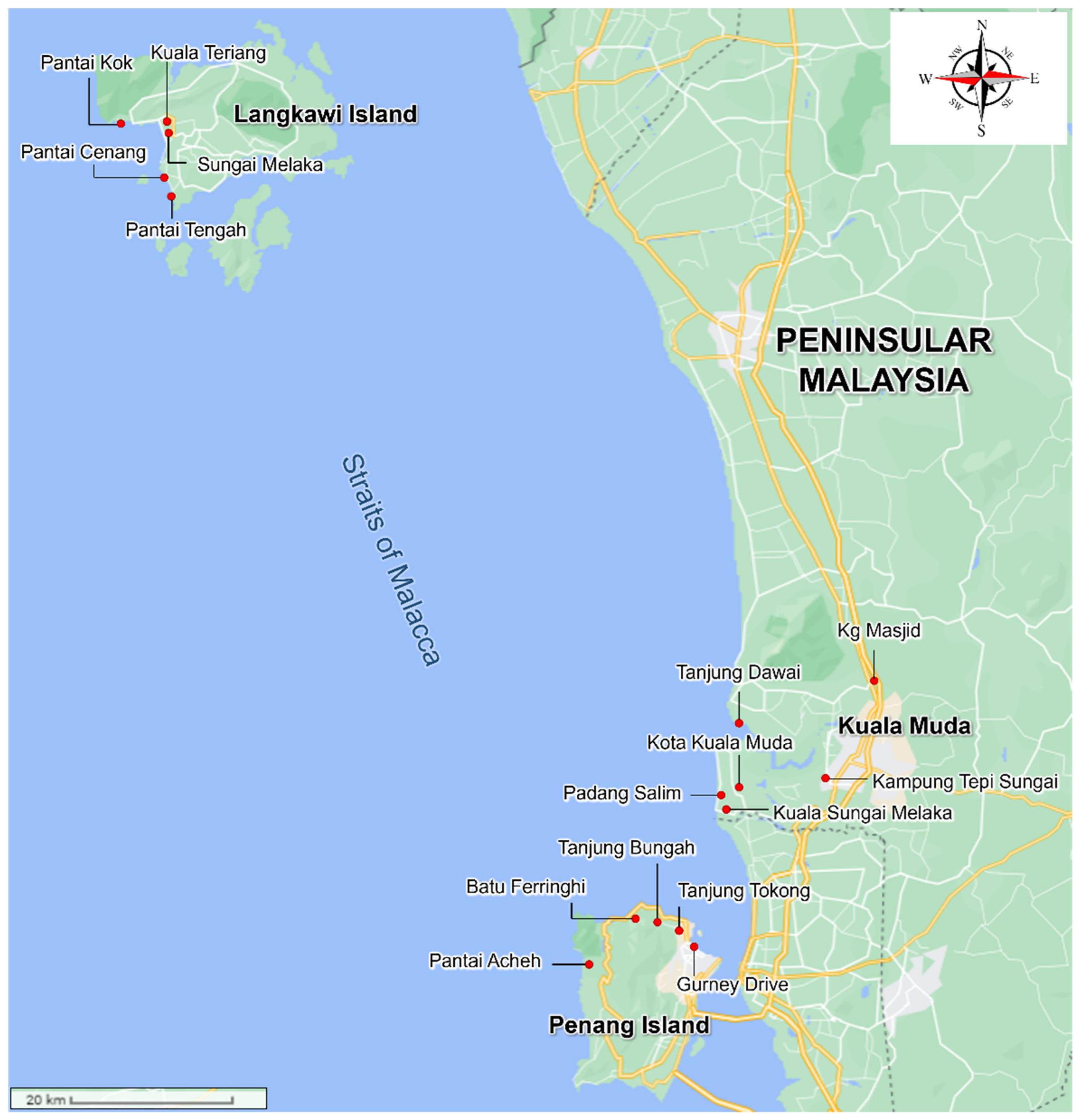

| Year | Event | Moment Magnitude (Mw) | Deaths |
|---|---|---|---|
| 1755 | Lisbon tsunami | 8.5–9.0 | ≈10,000 |
| 1896 | Meiji Sanriku tsunami | 8.2–8.5 | ≈2000 |
| 1908 | Messina tsunami | 7.1–7.3 | ≈10,000 |
| 1923 | Great Kanto tsunami | 7.9 | ≈2144 |
| 1933 | Sanriku tsunami | 8.4 | ≈3022 |
| 1945 | Makran tsunami | 8.1 | ≈4000 |
| 1952 | Kamchatka tsunami | 9.0 | ≈10,000 |
| 1960 | Chilean Tsunami | 9.5 | ≈2223 |
| 1976 | Moro Gulf tsunami | 8.0 | ≈6800 |
| 1998 | Papua New Guinea tsunami | 7.0 | ≈2205 |
| 2004 | Indian Ocean tsunami | 9.1–9.3 | ≈227,899 |
| 2011 | Tohoku tsunami | 9.0 | ≈18,453 |
| 2018 | Sulawesi tsunami | 7.5 | ≈2077 |
| Ref. | Wave Maker | Model Scaling | Bore Height/Inundation Depth/Wave Height (m) | Flow Velocity (m/s) | Wave Flume’s Width, w (m) | Structure Model’s Width, b (m) | Blockage Ratio b/w | Force Acquisition Frequency (Hz) | Remarks |
|---|---|---|---|---|---|---|---|---|---|
| [88] | Piston-type (wave paddle) | 1:10 | 0.05, 0.07 | - | 1.50 | Multiple tree models | - | - | Study on effect of various mangrove densities and tree arrangements on wave reduction |
| [81] | Dam-break | 1:35 | 0.04, 0.05, 0.06, 0.08 | - | 0.60 | 0.60 | 1.00 | - | Study on efficacy of seawall in reducing wave height and force on a building |
| [95,98] | Dam-break | 1:100 | 0.04, 0.05, 0.06, 0.08 | - | 0.60 | 0.15 | 0.25 | - | Study on wave forces acting on a bridge model with three girders |
| [93] | Dam-break | 1:100 | 0.04 | 1.20 | 1.00 | 0.10 | 0.10 | 50 | Preliminary study on tsunami-induced force and pressure on one- and two-storey buildings |
| [94] | Piston-type (slide type board) | 1:40 | 0.24, 0.28, 0.32, 0.36 | - | 1.50 | 1.38 | 0.92 | - | Preliminary study on tsunami horizontal and uplift forces on box girder bridge |
| [96] | Dam-break | 1:100 | 0.04, 0.06, 0.08 | 1.20, 1.70, 2.20 | 1.00 | 0.10 | 0.10 | 50 | Estimation of tsunami-induced pressure on one-, two-, three- and four-storey buildings |
| [97] | Piston-type (slide type board) | 1:40 | 0.04, 0.08, 0.12, 0.16, 0.20, 0.24, 0.28, 0.32, 0.36, 0.40 | - | 1.50 | 1.38 | 0.92 | 1000 | Study on horizontal force, vertical force and overturning moment on bridges with three to six girder beams |
| [99] | Dam-break | 1:5 | 0.60 | 5.20 | 2.10 | 0.74 | 0.35 | - | Study on impact of tsunami waterborne debris on structures |
| [102] | Dam-break | - | 0.07, 0.08 | 2.80, 2.90 | 0.35 | 0.05 | 0.13 | - | Study on impingement of Newtonian and non-Newtonian fluids on a vertical structure |
| [103] | Dam-break | 1:50 | - | 0.18 | - | - | - | - | Study on ability of various wall-opening configurations in reducing wave velocity |
| [105] | Dam-break | 1:10 | 0.22–0.27 | 1.98–2.51 | 1.50 | 1.50 | 1.00 | 1000 | Estimation of tsunami-induced pressure on a seawall fronted by 20% perforated section |
| [106] | Dam-break | 1:100 | 0.04, 0.06, 0.08 | 1.20, 1.70, 2.20 | 1.00 | Multiple building models | - | 50 | Study on influence of nearby buildings on tsunami-induced pressure on a building |
| [107] | Dam-break | 1:100 | 0.04, 0.06, 0.08 | 1.20, 1.70, 2.20 | 1.00 | 0.10 | 0.10 | 50 | Estimation of tsunami force on a building with elevated floor slab |
| [108] | Dam-break | 1:8 | 0.2, 0.3, 0.5, 0.6 | 2.80, 3.40, 4.50, 5.20 | 2.10 | 0.74 | 0.35 | - | Estimation of tsunami force on a double-storey reinforced concrete building model |
| [104] | Dam-break | 1:50 | 0.04, 0.07, 0.10 | 1.50, 2.10, 2.70 | 0.90 | 0.16 | 0.17 | 2000 | Estimation of tsunami force on internal wall of a building, considering various openings and wall configurations |
| [83] | - | 1:4 | 0.05, 0.10, 0.15, 0.20, 0.25, 0.30 | - | - | - | - | - | Study on wave transmission over a submerged breakwater WABCORE |
| [84] | - | - | 0.15, 0.20, 0.25 | - | 0.35 | 0.32 | 0.91 | - | Study on performance efficiency of membrane-type floating breakwaters in dissipating the wave energy |
| [116] | Dam-break | 1:50 | 0.04, 0.05, 0.06, 0.07, 0.08, 0.09, 0.10 | 1.50, 1.80, 1.90, 2.10, 2.40, 2.50, 2.70 | 0.90 | 0.16 | 0.17 | 2000 | Study on the effect of roof types (flat and gabled roofs) on tsunami wave flow mechanisms and induced loads on buildings |
Publisher’s Note: MDPI stays neutral with regard to jurisdictional claims in published maps and institutional affiliations. |
© 2022 by the authors. Licensee MDPI, Basel, Switzerland. This article is an open access article distributed under the terms and conditions of the Creative Commons Attribution (CC BY) license (https://creativecommons.org/licenses/by/4.0/).
Share and Cite
Moon, W.C.; Sidek, L.M.; Lau, T.L.; Puay, H.T.; Majid, T.A.; Wahab, A.K.A.; Teo, F.Y. A Shared Vision on the 2004 Indian Ocean Tsunami in Malaysia: Hazard Assessments, Post-Disaster Measures and Research. J. Mar. Sci. Eng. 2022, 10, 1088. https://doi.org/10.3390/jmse10081088
Moon WC, Sidek LM, Lau TL, Puay HT, Majid TA, Wahab AKA, Teo FY. A Shared Vision on the 2004 Indian Ocean Tsunami in Malaysia: Hazard Assessments, Post-Disaster Measures and Research. Journal of Marine Science and Engineering. 2022; 10(8):1088. https://doi.org/10.3390/jmse10081088
Chicago/Turabian StyleMoon, Wei Chek, Lariyah Mohd Sidek, Tze Liang Lau, How Tion Puay, Taksiah Abdul Majid, Ahmad Khairi Abd Wahab, and Fang Yenn Teo. 2022. "A Shared Vision on the 2004 Indian Ocean Tsunami in Malaysia: Hazard Assessments, Post-Disaster Measures and Research" Journal of Marine Science and Engineering 10, no. 8: 1088. https://doi.org/10.3390/jmse10081088
APA StyleMoon, W. C., Sidek, L. M., Lau, T. L., Puay, H. T., Majid, T. A., Wahab, A. K. A., & Teo, F. Y. (2022). A Shared Vision on the 2004 Indian Ocean Tsunami in Malaysia: Hazard Assessments, Post-Disaster Measures and Research. Journal of Marine Science and Engineering, 10(8), 1088. https://doi.org/10.3390/jmse10081088







